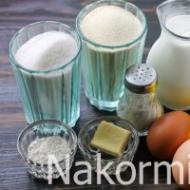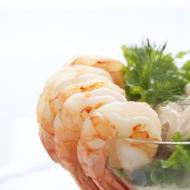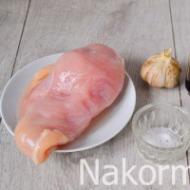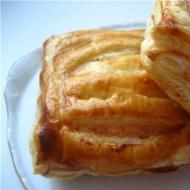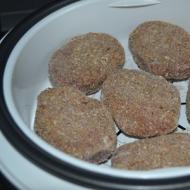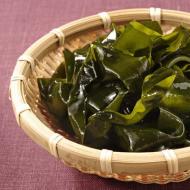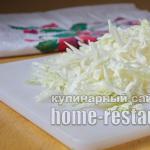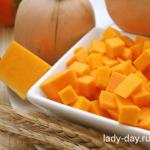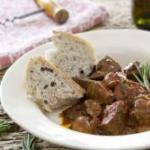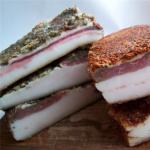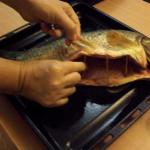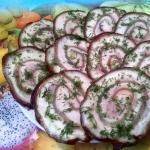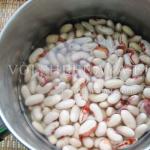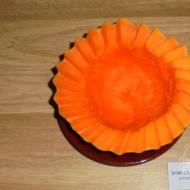
How to use ginger for medicinal purposes. Everything about ginger - benefits and harms, medicinal properties and contraindications. To prepare the sweets you will need
Nature has made sure that a person remains healthy throughout his life.
The developing pharmaceutical industry offers an abundance of drugs of domestic and foreign origin, which, moreover, are not affordable for everyone - drug prices are rising disproportionately to the increase in the income of the average Russian family. And if you add to this a dubious list of contraindications and side effects, you involuntarily recall the old saying: “”. But just a few decades ago, handfuls of tablets were replaced with natural medicines grown in one’s own garden or carefully donated by nature.
Folk recipes for all kinds of ailments were passed down from generation to generation as the highest value, because even the most experienced healers of that time could not doubt their effectiveness. Onions, garlic, ginseng, coltsfoot... The list of “natural healers” can be enumerated endlessly. But, perhaps, one of the most worthy places in it is occupied by ginger.
How ginger grows: botanical information
Looking at the ginger root sold in stores, it is difficult to imagine that this unsightly-looking plant has so many healing properties. However, it enjoyed enormous recognition and respect even before the invention of medicine - it is not for nothing that its name, translated from Sanskrit, is interpreted as “horned root” (due to its non-trivial shape) or “universal medicine” (due to its amazing properties).
Northern India is considered the birthplace of ginger, where more than 50% of the world “ginger market” is grown to this day. This perennial herbaceous plant does not grow on its own - it is grown with special care and scrupulousness on specially designated plantations to give the world a healing remedy for many ailments. However, in ancient times it was used not only as a medicine - many men used ginger as an aphrodisiac.
See, how ginger blooms, it is possible in the second year of the plant’s life. Spike-shaped inflorescences, consisting of pastel yellow petals framed by purple, do not appear on slender ginger stems as often as we would like - this should be facilitated by weather conditions, providing high humidity and heat. However, the wait is worth it because the ginger in bloom is an indescribably beautiful sight.
However, despite its external attractiveness, the greatest value of the plant is the fleshy rhizome - it contains a cocktail of antibacterial, vitamin and mineral additives, especially important for humans. Moreover, the properties are lost only slightly during processing, which means pickled or dried ginger root also brings undoubted benefits to the body.
Ginger: beneficial properties and chemical composition
The healing power of ginger can be explained by the unique combination of beneficial components included in its composition. Of particular importance among them are:
- Antioxidants represented by vitamins A, C, E, as well as magnesium and zinc. These substances are useful not only as a nutritional base for the body, but also as protective reserves against radiation, the harmful effects of ultraviolet radiation and, as a result, free radicals. In addition, antioxidants help prolong youth and preserve vital energy.
- Amino acids, including essential ones. They participate in the restoration of cellular composition, renewal of the body, hematopoiesis and the maintenance of all vital functions. Nicotinic and oleic acid. These components are the basis for harmonious metabolism, which means that these acids are indirectly responsible for energy balance.
- Mineral cocktail. Silicon, potassium, phosphorus, zinc... It would take a very long time to list the number of micro- and macroelements that make up ginger root. And each of them is important in its own way in maintaining normal life.
- Essential oils. An unimaginable aroma is far from the most important function of ether. These oils help strengthen the immune system and help the body resist pathogenic viruses, bacteria and fungi.
- Gingerol. This organic compound speeds up metabolic processes, relieves symptoms of inflammation and helps cleanse toxins.
However, these components are only a small part of the beneficial substances that ginger contains. That is why the plant has been used for medicinal purposes almost since its appearance. The beneficial effects of ginger infusions, grated or dried rhizomes are described in the treatise “On Medicinal Matter” by the ancient Greek scientist Dioscorides. It was he who, while engaged in a detailed study of ginger, began to use it as an antiemetic, intestinal and “eye” medicine, and then taught his contemporaries to treat the consequences of excessive celebration (simply, a hangover).
To this day, folk recipes based on ginger are used to treat all kinds of ailments:
- for colds: decoction, diluted juice or tea with ginger relieves symptoms of ARVI, flu, bronchitis, sore throat and even pneumonia, and inhalations using essential oil help
- with nasal congestion;
- for intestinal disorders: the mild laxative effect of ginger extract helps relieve symptoms of food poisoning, get rid of stomach pain, and remove waste and toxins from the intestines;
- for gynecological disorders: the beneficial effect of this plant affects the woman’s reproductive system, relieves the symptoms of inflammatory processes and facilitates their course;
- for disorders of the musculoskeletal system: in particular, ginger has established itself as an excellent medicine for rheumatism, arthritis, arthrosis and painful sensations in the joints;
- for diabetes: the plant has a positive effect on blood sugar levels;
- for vascular pathologies: ginger increases the elasticity of capillaries, helps cleanse them, reduces the risk of blood clots and improves cerebral circulation;
- for male ailments: this remedy helps prevent the occurrence of prostatitis and increases libido;
- for weight loss: ginger speeds up metabolism and improves the digestibility of fats, which means it promotes the rapid breakdown of fat deposits;
- in cosmetology: masks, creams and lotions based on ginger juice or infusion - a magical remedy for the first signs of aging, increased greasiness of the skin and acne.
Ginger: contraindications
Unfortunately, not everyone can take advantage of this storehouse of healing powers of nature - ginger has contraindications, although they are very modest, but they should not be discounted. So, you should approach self-medication with ginger root with caution in the following cases:
- during pregnancy, especially in the third trimester;
- young mothers whose babies are breastfed;
- if the age of the small patient is less than three years;
- with fever and temperature above 38°;
- those who suffer from stomach ulcers, gallstones, acute and chronic gastritis; for epilepsy.
In addition, in rare cases, hypersensitivity to the esters that are part of the rhizome occurs. This means that before using a ginger-based cosmetic product for the first time, it is best to conduct a small test: apply a little cream or lotion to the inside of the wrist and observe the area for several hours - if itching, redness and burning appear, it is better not to use ginger cosmetics.
In case of complex treatment, including the use of medications and folk remedies with ginger, it is better to consult a doctor, since the plant extract can affect the effectiveness of medications.
How to store ginger at home?
Since ginger can be used for food in absolutely any form - pickled, candied, dried, in the form of juice, infusion or tincture, tea, spice, etc. – many housewives don’t even think about how to preserve the healing properties of this unique plant, because there are a lot of options.
Knowing the benefits of ginger, most connoisseurs of this plant try to keep it fresh. However, even in the refrigerator, the rhizome remains usable for no more than a week, so this option is only suitable for short-term storage. But the dried root can retain its usefulness for as long as 4 months! At the same time, it is not at all necessary to use it dry - you can grind it into powder and use it as a flavoring additive to food, or soak it before use to restore its fresh appearance and shape.
In addition, the nutritional value of ginger is preserved even at low temperatures, so you can freeze the “home healer” by first wrapping it in cling film. True, it is best to chop it into portions before freezing - there is no point in re-freezing the plant, and cutting off the required piece from a frozen root can be extremely difficult. You can also put ginger puree, obtained using a blender or fine grater, into the freezer. Having spread it in a thin layer in a bag, you can break off the required amount of the ready-made “semi-finished product” for tea or decoction at any time.
Many people with a sweet tooth will enjoy candied ginger, which can be stored in the cold for about a month. And it’s very easy to prepare! All you need to do is cut the root into thin slices and boil them in syrup for 10 minutes (approximate ratio of water to sugar 1:1). However, it is not at all necessary to store the plant for a long time - knowing in what conditions and where ginger grows, you can always grow it at home. True, the “homemade version” will not be so useful, but all the necessary healing properties will be preserved.
When using ginger powder as a spice, keep in mind that dry rhizomes are much hotter than fresh ones. Based on this, you should choose the dosage so as not to overdo it and spoil the dish. By the way, when preparing dishes with fresh ginger, it is better to avoid wooden utensils - they absorb the ethereal smell too quickly, which means that the aromas of ginger will haunt you even where they are inappropriate.
The best folk recipes with ginger
The collection of traditional medicine can no longer accommodate the huge number of recipes that are prepared using ginger. They are used for colds and intestinal disorders, general fatigue and nervous tension, headaches and other ailments... It will take more than one month to try at least a tenth of them. However, the best of them have firmly settled in the kitchen and medicine cabinets of caring housewives.
Tea with ginger and lemon
This drink is considered a real elixir of health and longevity, because the harmonious combination of ginger and lemon fills it with a powerful dose of vitamins and microelements. And if you add a spoonful of honey as a sweetener, the tea can defeat any cold! All that is required for preparation is a few circles of ginger root, the same amount of lemon (for 1-2 servings), and you can add honey to taste. By adding the ingredients to boiling water, just boil them for just 1 minute - and you can enjoy aromatic tea that will fill the body with vitality and unshakable health!
Ginger with lemon. Blank
If you feel like you're starting to catch a cold, it's time to remember the miraculous power of ginger and lemon. A convenient solution is to make a preparation that can be stored in the refrigerator for several days. You can take it with you to the office or on the road and brew a healing drink as often as possible. The preparation is quite simple. We need to grate 150-200 g of fresh ginger root, finely chop 1 lemon along with zest, add 150-200 g of honey, mix. Next, the mixture should be placed in a glass jar and closed with a lid.
Ginger, lemon, honey
This is a magic formula that helps you get rid of a cold much faster. Of course, it can be used not only during illness, but also during viral infections to strengthen the immune system. Brewing ginger with lemon and honey is a good health habit.
Ginger compress
A gauze compress, inside which you need to wrap ginger pulp, will help get rid of painful sensations. Preparing it couldn’t be easier: you can grate the fresh root or use dry powder, the main thing is to dilute it with water until it turns into a puree. By applying such a compress to the location of the pain (for example, the forehead for migraines or the lower back for back pain), you can relieve the symptom in 10-20 minutes.
Ginger gum
If you experience nausea, toxicosis or seasickness, you should chew a slice of fresh ginger root or prepare a special paste of dried spices with the addition of a few drops of water. In this case, it is not at all necessary to swallow “chewing gum” - the released esters, together with saliva, will enter the gastrointestinal tract and relieve discomfort.
By turning to the secrets of traditional medicine, you can get rid of almost any ailment with the help of a unique plant - ginger. So why poison yourself with untested medicines if everything you need is in the kitchen of every housewife? Remember: health priceless!
Ginger has many forms and uses. It is valued in folk medicine, recognized in official medicine and loved on all continents of the earth. It is known as the most bizarre root vegetable, the richest herbal product in active components and an effective assistant in the fight against many diseases. How and where can it be used and are there any peculiarities in its application?
Use in folk and official medicine
Ginger is rarely the only ingredient. Its pungent taste and pronounced aroma with light citrus notes do not allow it to be used in large quantities as a food and medicinal product. How to use ginger correctly and why is it especially useful?
First, let's talk about the variety of forms of using spices. Both fresh and ground root are suitable for medicinal purposes and use as a food product in cooking. Fresh has a more delicate taste and aroma, rich in vitamins, amino acids, and essential oils. Ground spice has a pronounced warming property, so it is often used to treat sore joints, sprains, and bruises.
Teas, drinks, mixtures, decoctions, compresses, pastes, and tinctures are prepared from ginger. In what other forms can ginger be used? In cooking there are many recipes for baking, low-alcohol drinks made from ginger, for example, ale, jam, compotes. The root is pickled and candied. The scope and forms of use of the root are varied: from powerful medicines (tincture) to aromatic desserts (gingerbreads and cookies).
Tincture is one of the most potent medicines made from ginger.
The use of ginger in folk medicine is due to the presence of the following active substances in it, which can have a comprehensive effect on many problems in the body:
- vitamins A, E, C, group B;
- micro- and macroelements: potassium, phosphorus, magnesium, manganese, aluminum, silicon, calcium, iron, chromium;
- linoleic, nicotinic, oleic, caprylic acids;
- aspargine;
- choline;
- essential amino acids;
- gingerol;
- bisabolene;
- tannin;
- flavonoids;
- caffeine and others.
The pronounced properties of ginger in any form are: anti-inflammatory, disinfectant, antimicrobial, tonic, stimulating, warming. It is recommended to drink ginger in order to warm up, relieve stress, and get a dose of vigor and good mood. To treat colds accompanied by body aches, chills, cough and nasal congestion, folk medicine uses a concentrated ginger drink (1 tablespoon of crushed root per 250 ml of water), inhalation with ginger oil, rinsing with juice.
It is not recommended to drink hot ginger teas at high temperatures, since the ability of the spice to warm and increase blood circulation can provoke a greater increase in body temperature with additional stress on the heart and blood vessels. Also, you should not use the spice if you have internal bleeding or suspicion of it.

To improve digestion, ground spice is more often used than fresh root.
The use of ginger since the times of Ancient China is associated with its special effect on the digestive system. It was used to prevent poisoning and treat the consequences. The root contains many antimicrobial, antibacterial and antiviral components that gently heal the microflora of the stomach and intestines, kill pathogens, and cleanse them of toxins and toxic substances.
In addition, ginger root promotes the normal production of digestive enzymes, accelerates food digestion, improves the absorption of nutrients and prevents fat deposition. The spice is an irritant, therefore it is contraindicated for ulcers, gastritis, pancreatitis, and serious liver diseases.
What diseases can ginger help with?
- Diseases of the musculoskeletal system: arthritis, arthrosis, spondylitis, rheumatism, etc. The effectiveness of compresses with ground root is due to its pronounced warming properties, the ability to penetrate deep into the muscles, and the analgesic effect on the problem area. Additionally, ginger improves blood circulation in the affected joint, muscle, and cartilage.
- Tonsillitis, laryngitis, tracheitis, bronchitis and pneumonia. Disinfects mucous membranes, acts as a mucolytic, relieves inflammation, restores affected areas, and softens dry cough.
- Weakened immunity. Enriches the diet with vitamins, micro- and macroelements that help improve the functioning of the immune system, and increases the speed of the immune response to viruses and bacteria.
- Intestinal infections (acts as a disinfectant), slow metabolism (gingerol in the root accelerates the breakdown of proteins, fats and carbohydrates).
- Inflammatory diseases of the female and male genital area, PMS. Helps in the treatment of vaginitis, colpitis, thrush, cystitis, prostatitis. Relieves PMS pain, tension in the mammary glands, increases potency and female libido.
In official medicine they are used in the production of cough and cold medicines. These are syrups and lozenges. You can also buy ginger oil at the pharmacy, which is used for inhalation and as a massage cream.
Numerous studies conducted in institutes around the world suggest that in the near future there will be much more natural and effective medicines from ginger, because there is information about the benefits of the spice in the fight against breast, rectal, prostate and other cancerous tumors .
Use in cooking
Ginger was first used in Europe as a spice in cooking. Only people from privileged classes could buy and eat it due to its too high cost. At first it was added to meat and fish, and later recipes for gingerbread and cookies with dried spice became popular. Today, the list of dishes to which ginger is added according to the recipe is difficult to place in one cookbook. These are soft and alcoholic drinks, cookies, gingerbread, soups, meat and fish dishes, salads, jams. Ginger is made from ginger, marinated in thin slices and served with sushi.
Fish dishes with ginger are considered classics of the genre. It neutralizes the not always pleasant fishy smell, adds piquancy to dishes, and allows you to make meat softer and more tender when it is added to the marinade.
Neutralizes the aftertaste of one dish so that you can move on to another with clean receptors. This property of the root is used in Japanese cuisine when serving sushi. Some gourmets and true admirers of the plant eat it as a side dish or an independent dish.

Candied fruits are one of the most delicious and healthy desserts made from horned root.
Many raw salads intended for colon cleansing also contain thinly sliced ginger. It helps remove toxins and waste, improve the digestive tract, and is a source of dietary fiber, so it is digested slowly and gives you a feeling of fullness for a long time. Ground spice can be added to almost every dish, the main thing is to correctly follow the proportions.
In cooking they say this: it makes the most complex and heaviest dish easy to digest, simplifying the work of the digestive system. Its aroma already predisposes you to a pleasant meal, and its taste will make you repeat the recipe again and again. Wherever ginger is added, in whatever dishes it is present, it will make their taste unusual and their aroma original.
Ginger for beauty and youth
Ginger root is a rich source of antioxidants. These are vitamins, flavonoids and fatty acids, which guard beauty and health. In cosmetology, both ginger essential oil and various extracts are used. They are included in anti-aging creams, anti-inflammatory agents for problem skin, and shampoos for hair loss.
At home, ginger is used in the form of juice, dry powder and gruel. Juice diluted with boiled water can be applied with a cotton swab to problem areas of the skin, acne, inflammation to disinfect the skin, have a slight drying effect and improve the health of the epidermis. In a similar form, it can be used to apply to hair to strengthen and stimulate hair growth. Simply pour the diluted juice into a container with a spray bottle and spray along the entire length of your hair. If the procedure is carried out in the evening, then you can wash your hair only in the morning.

Using ginger masks you can lighten your hair, combat dandruff and make your curls smooth and shiny.
Various face and hair masks with plant powder or juice are widely used. So, to nourish hair, accelerate its growth and improve the health of the scalp, use ground ginger diluted in water with the addition of olive, almond, peach or other oils. This mask may tingle the skin slightly and warm it up.
Ginger juice is suitable as one of the additional ingredients of masks for oily and problem skin. It is able to regulate the volume of sebum secreted, cleanses the skin well of impurities, kills microbial flora, nourishes with antioxidant vitamins, and heals minor wounds.
It is correct to start using the spice for external use with small portions - a few drops. Ginger can cause allergies, so a sensitivity test can be done to rule out unpleasant consequences.
The best spice for weight loss
Herbs and spices, as stimulants for the active functioning of the digestive system, are used in many diets. They are used as food additives or ingredients in fat-burning drinks. Ginger began to be used as a means of losing weight in Europe not so long ago. Back in the 70s of the last century, some studies by American and French scientists claimed that the active substances contained in both fresh and dried roots can help people get rid of extra pounds and make a sluggish metabolism much more active.
Today, the key to successful fat burning and weight normalization is the correct and regular use of ginger drinks. Warm tea with fresh or ground spices should be used by anyone who wants to lose weight. At the stage of active weight loss, you need to drink 1.5 liters of tea daily, prepared from 1 tablespoon of fresh chopped ginger, poured a glass of hot water and steeped for 5-10 minutes.
To enhance the effect, add a teaspoon of lemon juice and honey to the tea. Always drink the drink warm and before meals. To force the body to burn fat more actively, it is necessary to strictly limit the amount of fat consumed in food. Then, to obtain the required amount of energy, the body will begin to consume lipid deposits concentrated in the abdomen and other parts of the body.

Ginger is combined with tea and green coffee to enhance fat burning.
Even more effective, but harsh and has contraindications, is the use of a combination of ginger and garlic. These two products complement and enhance each other's properties to improve digestion and fat breakdown. They are taken in equal proportions, crushed, mixed with lemon juice and honey. Next, teas are prepared from the mass. One dessert spoon of the mixture is poured into a glass of hot water, left for 5 minutes and drunk before meals.
A similar drink can be prepared in a thermos for the whole day. To do this, one small root and head of garlic are crushed, poured with 1.5 liters of hot water, left in a thermos for 30 minutes, filtered and placed again in a thermos to maintain the optimal temperature for drinking. When drinking, you can add lemon and honey to the cup.
For people who are satisfied with their own figure, ginger can be used to maintain a stable weight. To do this, it is enough to flavor meat dishes with ground ginger several times a week and drink regular black or green tea with a slice of fresh root every day.
Ginger is a spice with a capital letter. If in the Middle Ages its history and origin were shrouded in secrets and legends to increase its value, today a lot of research leaves no doubt about its benefits for the human body. It is widely used on all continents, its price is affordable for everyone, and the benefits can only be felt by those who know all the secrets of its use.
Ginger became popular in Russia quite recently, but meanwhile it is a very ancient spice, it was highly valued back in Ancient Rome, and was brought from the East. It was added to meat dishes, desserts, stews, drinks, and various gingerbreads were baked. Today this culture is cultivated mainly in China, Ceylon, India, Indonesia, as well as in Australia, Jamaica, and West Africa (Nigeria).
Before we talk about ginger root - its health benefits and harms, it is worth paying attention to the fact that in Russian supermarkets fresh and pickled ginger tubers are most often of Chinese origin. Therefore, it is important to know that you cannot use fresh ginger right away. For the production of all agricultural crops in China, huge doses of chemicals and pesticides are used; all products are also processed before transportation (see harm to Chinese).
Therefore, before using fresh ginger, it must be thoroughly washed, peeled, and then placed in water for an hour to reduce the toxic effects on the body. Dry powder usually has foreign impurities and coarse varieties of roots are used for it - it is better not to use it. The dried root changes its properties, the anti-inflammatory and analgesic effects are enhanced, but the stimulation of digestion is reduced.
The industrial production of this spice in China is very developed - it is preserved in syrup, pickled, candied (boiled in sugar syrup), and used as an infusion. In countries where fresh ginger is available, the dried product is not in demand because the powder has a dull taste and aroma. Commercial varieties of ginger, depending on processing, are divided into:
- White - Bengal or Jamaican - is the highest grade
- Bleached - peeled and soaked in lime solution
- Black Barbadian-unrefined, but simply scalded or boiled
Non-flaccid, dense, smooth fresh roots are considered to be of good quality; when broken off, they should crunch; the aroma and taste of such ginger is stronger. When choosing, you should give preference to a light and shiny root; dark is much worse than light. If you purchase powder, it should not be white-gray, but only sandy or light yellow, and it should also be hermetically packaged.
Useful, healing properties of ginger root
Ginger contains a wide variety of beneficial substances; it has a very complex composition, including up to 400 chemical compounds, so it has a lot of medicinal properties. The root is given a pleasant aroma by essential oils, of which it contains about 1-3%, a burning taste is given by Gingerol (a phenol-like substance), it is saturated with natural sugars, carbohydrates, fats, resins, vitamins, fiber, and minerals:
What are the health benefits of ginger?
Helps improve the functioning of the gastrointestinal tract
Ginger is useful because it improves appetite, while speeding up metabolism; its use is recommended for disorders of cholesterol and fat metabolism, thanks to the essential amino acids that are part of it. This spice also contains substances that improve blood circulation, so it speeds up metabolism and can be used by those who are struggling with excess weight, since stimulating the process of burning calories promotes weight loss. Moreover, ginger helps normalize intestinal function and regulates peristalsis. Foods that are flavored with ginger root can be better absorbed by the body.
Anti-inflammatory effect
The most popular use of ginger root is the prevention and treatment of acute respiratory diseases, colds, bronchitis, and sore throats, since it has a moderate anti-inflammatory effect. In some European countries, ginger ale and beer are used to treat colds; they are heated before drinking and are believed to lead to a quick recovery. In China, egg omelette with ginger is a folk remedy for coughs; special cough lozenges are also made from the root.
Analgesic effect
For any muscle, headache, or joint pain, it helps reduce pain. At home, you can use this property of ginger in the following way: grated root or its powder is mixed with water and applied as a compress to a painful area.
Antiemetic
Another beneficial property of ginger is its antiemetic effect. Numerous studies claim that this product is useful in reducing nausea of any kind. It reduces the manifestations of toxicosis during pregnancy (see), with seasickness, and reduces nausea as a consequence of chemotherapy, nausea during motion sickness in transport.
Immunostimulating
The benefit of ginger root also lies in the fact that it is a fairly strong antioxidant, it calms the nervous system, improves memory, strengthens the immune system, helps cope with stress, increases visual acuity, concentration, helps with colds, and is an excellent tonic.
Ginger root contraindications and potential health risks
There is a lot of information about the medicinal properties of ginger, but for various diseases it can harm health. The benefits and harms of ginger should be taken into account by people who have any serious health problems or chronic diseases. Many people believe that if this is a herbal remedy, then it can be used by everyone without restrictions without harm to health. Ginger has certain contraindications and you should always consult your doctor before consuming it.
Ginger should not be used simultaneously with certain medications:
- antiarrhythmic drugs;
- drugs that lower blood pressure;
- medications that stimulate the work of the heart muscle;
- sugar-lowering drugs - it enhances their effect, which leads to an increase in their effect and side effects (see). It increases the risk of hypokalemia and also reduces the effectiveness of beta-blockers.
Its use reduces blood clotting; this should be taken into account when taking various medications that have the same side effects. If there is a tendency to bleeding and damage to small blood vessels, its use is contraindicated (, etc.)
You should not take it if you have a fever or high temperature - it can contribute to its increase. For viral infections, colds with a slight fever, it is acceptable to take it, but for flu with a high temperature, it should not be used.
Potential harm from ginger root is possible in case of stroke, coronary heart disease, heart attack and pre-infarction condition, and hypertension. In the 2nd and 3rd trimester of pregnancy, its use is not advisable, as it can cause an increase in blood pressure.
For skin diseases, ginger can cause skin irritation or aggravate existing chronic skin diseases.
It is contraindicated for any liver diseases - hepatitis, as well as for cholelithiasis.
Everything is good in moderation; if you consume ginger in excess, allergic reactions, diarrhea or vomiting can occur, so you should not abuse this product and if you experience indigestion or allergies, you should stop consuming it.
How to store ginger root?
- The entire supply of aromatic substances and essential oils is located under the skin, so it should be cleaned carefully and thinly
- The fresh root can remain fresh when refrigerated for up to a week. The dry root can retain its beneficial properties for about 4 months.
- When grinding it, it is better not to use a wooden cutting board, which absorbs the juice of the root.
- Ginger juice can be irritating to mucous membranes, so after contact with fresh root you should wash your hands thoroughly.
- For chopping, it is better to use a grater, it will help get rid of the hard veins located in the root
- To preserve ginger, you can peel it and infuse it with vodka, wine, and use both the root itself and the flavored drink as a seasoning for several weeks.
The properties of ginger root are striking in their diversity. This allows us to call ginger a truly universal plant, the uses of which can only surprise. Ginger has rejuvenating and nourishing properties, therefore it is used by cosmetologists as an ingredient for masks and creams. Ginger root has fat burning properties. Weight loss drinks are prepared from the plant, it is added to tea and decoctions are prepared that help speed up metabolism and improve the functioning of the digestive system.
Ginger has anti-inflammatory and analgesic properties. This is why the plant is so popular in folk medicine. Fresh ginger root is used to prepare soothing and tonic drinks and very exotic dishes. A cup of tea with honey and ginger is the best invigorating remedy that tones the body and gives a boost of energy for the whole day.
Ginger root calories
The calorie content of ginger root is only 80 kcal per 100 g, this makes the plant not only healthy, but also dietary. The nutritional value of fresh ginger is 1.82 g protein, 15.77 g carbohydrates and 0.75 g fat. But ground ginger, which is sold as a spice, contains 347 kcal per 100 g. The nutritional value of ground ginger differs from fresh ginger, as ground ginger contains 5.95 g of fat, 9.12 g of protein and 58.29 g of carbohydrates. The plant is rich in vitamins and minerals. Ginger root contains ascorbic acid, vitamins B1, B2 and B3, as well as retinol acetate, that is, vitamin A. As for minerals, ginger root contains phosphorus, magnesium, potassium, sodium and calcium.
In addition to vitamins and minerals, the plant contains amino acids: leisine, threonine, valine, tryptophan, phenylanine. Ginger contains all known acids: oleic, nicotinic, caprylic, and so on. Ginger rhizome contains borneol, caenol, caphene, gingerin and other substances. This composition speaks of the universal properties of ginger and the unlimited possibilities of its use.
Effect of ginger root on the body
The effect of ginger root on the body depends entirely on the purpose of its use, the components with which the plant is used and the method of application.
- For disorders of the digestive system, ginger root has a stimulating and cleansing effect on the body. This helps improve appetite, the formation of gastric juice and alleviate a number of diseases of the gastrointestinal tract.
- The use of ginger root in case of poisoning has cleansing properties on the body, removes toxins and poisons, and has a mild laxative effect.
- Ginger root has a general strengthening effect and stimulates the immune system. Spice has a positive effect on memory, improves cerebral circulation, and prevents atherosclerosis.
A small amount of ginger added to tea or food can reduce cholesterol levels. Ginger has a stimulating effect, stimulates potency and libido. The plant is valued in cosmetology, as it is used for weight loss and getting rid of cellulite, as an ingredient in anti-aging products. The effect that ginger root has on the body is also known in gynecology; the plant treats infertility and helps to get a bright orgasm. Regular consumption of ginger will improve the condition of the gums, freshen breath and normalize the functioning of the thyroid gland.
Medicinal properties of ginger root
The healing properties of ginger root are used in traditional medicine and have been known since ancient times. The plant has expectorant, anti-inflammatory, bactericidal and antimicrobial medicinal properties. That is why ginger is recommended to be taken for respiratory diseases, colds, and sore throat. The choleretic and laxative properties of the plant help to safely cleanse the walls of blood vessels from atherosclerotic plaques, that is, ginger has anti-arteriosclerotic healing properties.
Since ginger stimulates the digestive system, it has stimulating healing properties on the body, which prevent the accumulation of cholesterol and remove its excess. The plant is especially valued for its antispasmodic properties and stimulation of blood circulation. Ginger root has a positive effect on female and male potency, stimulates sexual arousal and tones. Using ginger with other medicinal herbs and plants only enhances their effect. All this makes ginger root a valuable and versatile plant with limitless medicinal properties.
Benefits of ginger root
The benefits of ginger root for the body are manifested in its medicinal properties. The universal composition of the plant has a bactericidal, anti-inflammatory, soothing, tonic and choleretic effect.
The benefits of ginger root are based on the rich composition of the plant. Ginger contains minerals, vitamins, essential oils and amino acids, fiber, proteins, and carbohydrates. The plant improves human immunity due to its general strengthening properties. The spice improves digestion and speeds up metabolism, which is why ginger is a popular remedy for weight loss.
Harm of ginger root
Damage to ginger root can occur due to improper use of the plant or high dosage. When using ginger as a remedy, it is worth knowing that the spice has a warming effect, so ginger should not be used at high temperatures and heat.
Contraindications to the use of ginger root are based on its properties. The plant is not recommended for use if you have a stomach ulcer, diseases of the gastrointestinal tract, esophageal reflux or gallstones. Ginger should be taken with extreme caution during pregnancy and breastfeeding. So, in the first trimester, ginger is used to relieve the symptoms of toxicosis. But in the last months of pregnancy, consuming the spice is strictly prohibited, as this can cause premature birth or lead to complications during the birth process.
Ginger contains cardioactive substances that increase the load on the cardiovascular system and increase heart rate. Therefore, the plant is not recommended for use by elderly people and those who suffer from heart disease or take antihypertensive medications.
How to use ginger root?
How to use ginger root to get maximum benefits? First of all, it is worth saying that only the root part of the plant is consumed, since it contains all the microelements, vitamins, minerals, that is, nutrients that are necessary for the treatment and prevention of health problems. As for the process of consuming ginger, it is worth deciding for what purpose you need it. Do you plan to use the root as a spice and add it when preparing dishes, or do you plan to brew medicinal teas and make infusions from it? The method of storing the plant depends on the purpose of use; ginger can be frozen, dried or consumed fresh.
If ginger root is used in cooking, it is best to leave it fresh. When using the plant for medicinal purposes, ginger is crushed (grated or cut into slices), so it must also be fresh. By the way, ginger in powder form is suitable for medicinal infusions and lotions, which can be purchased in any spice department. This ginger is used to treat joint problems and rheumatism. Do not forget that the beneficial properties of the plant directly depend on its storage, preparation and use.
How to brew ginger root?
How to brew ginger root depends entirely on the purpose of using the plant. Ginger is poured with boiling water and infused; the infusion time depends on how the plant is used. If a medicinal tea is prepared from ginger, then the plant is brewed for 30 minutes; if it is a medicinal tincture, then the brewing process can take 2-6 hours. Let's look at a few recipes that will help you learn how to brew ginger root.
- Fresh ginger root, about 100 g, cut into thin slices, cut a couple of lemon and orange slices. Pour boiling water over the ingredients and leave to steep for 20-30 minutes. After the tea has steeped, you can strain it and drink it. Please note that the combination of ginger with citrus is an excellent option for toning the body and supporting the immune system during the cold season.
- Cut the ginger root into thin slices or cubes and pour boiling water over it. The tea must steep for at least six hours. After this, it must be strained, heated and drunk only hot, adding a spoonful of honey and mint to the cup. By brewing ginger for 4-6 hours, the plant releases all its beneficial substances into the water, this makes the tea healthy and tasty.
- Grind about 100 g of fresh ginger in a blender or three on a fine grater. Pour hot water over the ginger pulp (a spoonful of ginger per 500 ml of boiling water) and put it on low heat for 10-15 minutes. After the ginger has boiled, add a pinch of ground black pepper to the drink. Let the drink cool and strain. When consumed, it is recommended to add lemon juice and honey to the ginger drink. This recipe will help cope with colds and seasonal ailments.
Dried ginger root
Dried ginger root is a popular spice used in cooking. Dried ginger powder is found in herbal preparations and mixtures. Dried spice is used to treat diseases of the gastrointestinal tract, to alleviate the side effects of chemotherapy, for toxicosis and colds, and problems with the musculoskeletal system. Let's look at the basic methods of using dried ginger root.
- If you have dysentery or poisoning, then take 0.5 g of ginger 3-4 times a day. Dried ginger root perfectly stimulates appetite and restores digestion; just take 2 g before meals.
- For sore throats and sore throats, rinsing with dried ginger will be effective. Pour a teaspoon of powder into a glass of boiling water, cover with a lid and leave for 10 minutes. After this, the product must be filtered, cooled and can be used for rinsing.
- If the first signs of a cold appear, dried ginger will help prevent the disease. Before going to bed, pour ginger powder into your socks, put on your socks and go to bed. You can also make a warming compress from dried ginger. Dilute ginger powder with water to obtain a creamy mass and rub your feet with it. For this procedure to be effective, it is recommended to steam your feet first. Using this recipe, you can prepare mustard plasters for the back and chest.
- If you get motion sickness in transport, add a spoonful of dried ginger to a bottle of mineral water and drink a little before your trip. At the first symptoms of nausea, take a sip of ginger water.
Ginger root extract
Ginger root extract is a rejuvenating and tonic agent. The extract is used in cosmetology, to prepare masks for hair and skin. Ginger normalizes sebum secretion, effectively removes toxins and waste from skin cells, and has an antiseptic effect. Hair masks made from ginger extract warm the scalp, which improves its nutrition and blood circulation. Such masks accelerate hair growth and help get rid of dandruff. Cosmetologists value ginger root for its anti-aging and antioxidant properties.
Ginger root extract normalizes oily skin, tightens and tones it. The extract is used to prepare lotions and creams for oily skin, anti-aging and toning products for the face and eyes, anti-cellulite creams and stretch marks.
Ginger root for men
Ginger root for men acts as a powerful and absolutely safe aphrodisiac. Ginger treats impotence, increases libido and eliminates prostatitis. Regular consumption of tea with ginger root improves blood circulation, which promotes rejuvenation and healing of the entire body. Ginger for men is not only an assistant in sexual matters, but also a storehouse of useful vitamins and amino acids that support physical health and increase stamina.
Regular consumption of a small amount of ginger with food or drinks helps keep the body in good shape and the immune system at its best. If you are going on a romantic date, then a glass of ginger infusion or tea with this spice will make your date unforgettable.
Ginger root for potency
Ginger root for potency is considered an effective and, most importantly, safe remedy. It’s not for nothing that ginger is called a herbal aphrodisiac and the fruit of love. The plant increases libido and improves processes and blood circulation, which promotes long-lasting and persistent erections. Many sex therapists claim that ginger oil is an ideal remedy for an unforgettable night and numerous sexual intercourses.
Ginger increases potency thanks to its essential oils, vitamins, microelements and amino acids, which have a complex effect on the body, acting as a stimulant. If you regularly use ginger root, you can forget about problems with potency forever. This is especially true for men who work physically or regularly experience stressful situations, which leads to a decrease in libido function.
Ginger root for women
Ginger root is as beneficial for women as it is for men. The plant is used to prepare cosmetics and for medicinal purposes. Ginger is the best assistant in the fight for a slim body, healthy skin, silky hair and good mood. Ginger root for women is a source of youth and beauty.
Ginger relieves puffiness, stimulates the regeneration of skin cells, which speeds up the healing process of small wounds, cuts and scratches. Ginger scrubs help fight cellulite, tighten the skin, making it soft and elastic. Regular consumption of tea and fresh ginger root and honey tones the body and restores the protective functions of the immune system.
Ginger root during pregnancy
Ginger root during pregnancy can only be used in the first trimester. Ginger acts as a sedative, antispasmodic and relaxant. It is the use of ginger tea or decoction that helps get rid of the symptoms of toxicosis, eliminate headaches, dizziness and improve the digestion process.
Very often, ginger root is used during pregnancy as a safe and effective remedy in the fight against colds and inflammatory diseases. Women are advised to add fresh plant root to tea and favorite drinks. The only thing that needs to be observed is the dosage. Pregnant women are not recommended to take a lot of ginger, as the plant can lead to fever and other negative consequences for both mother and baby.
Ginger root for nursing mothers
Ginger root is not recommended for nursing mothers to use, since all the active components of the plant, together with mother's milk, enter the baby's body and significantly spoil the taste of the milk. This may affect the child's well-being. But we are talking about high doses of the plant. If you add a little spice to tea or dishes, it will not only be tasty, but also healthy and will not spoil the taste of milk.
Ginger root can be added to nursing mothers in soups, as a seasoning for side dishes, in teas and drinks. But do not forget that ginger is a good tonic, so during lactation it is allowed to be consumed only in the first half of the day. For a woman who has recently given birth, ginger is an excellent remedy that will help restore the body, remove waste and toxins, and strengthen the walls of blood vessels. Please note that many pediatricians and gynecologists do not recommend the use of ginger for nursing mothers if the baby is less than six months old.
Ginger root for breastfeeding
Ginger root can only be consumed in small quantities during breastfeeding. Such precautions are explained by the fact that when ginger enters the mother’s body, it is excreted in breast milk and affects its taste. This leads to nutritional problems in the child (colic, dysbacteriosis, irritation).
But if a nursing mother adds a small amount of the plant to food and drinks, this will not lead to the appearance of unpleasant symptoms. Consumption of ginger root during breastfeeding helps normalize the functioning of the female body, improves digestion processes and the functioning of the gastrointestinal tract, normalizes blood pressure and stimulates the circulatory system. In addition, ginger speeds up metabolism, which allows you to return your figure to normal after childbirth.
Ginger root for children
Ginger root for children is allowed for use only after two years. This is due to the fact that the plant, if it enters an unprotected child’s body, can cause irritation and problems with the digestive and gastrointestinal tract. For older children, ginger can be given as a preventive additive in tea and drinks, or added to food. The only thing worth controlling is the number of plants. Try to prevent your child from receiving too hot a dose of aromatic spice. Since this will discourage the baby from consuming ginger.
Ginger root for children can be used in making desserts and drinks. Ginger can be used as jam and or candied fruit. Let's look at a few ginger recipes for children.
- Citrus tea with ginger
Take 20 g of fresh ginger root, grind it and put it in a cup. Grate some zest from the orange and lemon. Pour boiling water over everything and add a little green tea. If desired, you can not add green tea to the drink, but add a spoonful of natural honey for sweetness.
- Sugar ginger sticks
100 g of fresh ginger root must be carefully peeled and cut into thin oblong slices. Place the ginger in a saucepan, add lemon and orange slices, 500 g of granulated sugar and 200 ml of water. Place everything on low heat and stir. The ginger should cook and become translucent. After this, we pull the ginger out of the citrus caramel and lay it out on parchment until completely dry. Sugar caramel can be used as an addition to tea.
How to store ginger root?
How to store ginger root is a very interesting question, since the plant must retain its medicinal properties, but at the same time, neither rot nor deteriorate. The storage method depends on the form of ginger you have. Let's look at the rules for storing ginger root.
- It is recommended to store fresh ginger in the freezer. This allows you to preserve the medicinal properties of the plant for a long time. Before freezing, ginger must be washed, peeled and grated. After this, the plant must be folded into a plastic bag, hermetically sealed, after removing the air, and stored in the freezer.
- If you plan to use ginger in the near future, the root of the plant must be peeled, wrapped in a bag and placed in the refrigerator.
- Candied ginger will keep in the refrigerator for about 30 days. To prepare candied ginger, place thin slices of the plant in a saucepan, add sugar and add a little water. As soon as the ginger becomes translucent, it must be removed from the syrup and dried.
- Ginger can also be stored in the form of an alcohol tincture. To prepare it, grate 100 g of ginger and pour in a liter of vodka. After this, put the tincture in the refrigerator to infuse for 14 days, remembering to shake the jar.
Ginger is a tonic and stimulator of the body's internal processes. But it can be used externally as a skin care product and wound disinfectant. It has been used in cooking and medicine for thousands of years, although all its properties have not yet been studied due to the complexity of its composition. How exactly does it affect a person and what are its most pronounced properties?
General properties of ginger
Ginger is effective both fresh and ground. The positive effect of ginger on the human body is due to the content of a large amount of vitamins, amino acids, essential oils, micro- and macroelements and other complex compounds, which in general act as biologically active components. It really contains a lot of magnesium and calcium, niacin and ascorbic acid, phosphorus and nicotinic acid. It contains a lot of gingerol - a rare polyphenol with pronounced properties, among which the effect on metabolic processes within the body is especially noted.
Young root is less fibrous and more aromatic
If we talk in general about how a spice acts on the body, it is necessary to highlight its main properties.
- A tonic, which is expressed in increasing vitality, fighting fatigue and drowsiness. This is a more gentle analogue of caffeine that does not actively excite the nervous system.
- Anti-inflammatory, provided with phytoncides, allowing the use of ginger to treat diseases of the throat, oral cavity, intestines, and genitourinary system.
- An anesthetic, expressed in the ability to relieve spasms of smooth muscles and more. Can be used for headaches, menstrual pain, discomfort in muscles and joints.
- Health-improving, concerns the digestive system and is expressed in the improvement of the mucous membrane of the stomach and intestines.
- Carminative, allowing to relieve bloating and increased gas formation.
- Immuno-strengthening.
If we talk about how ginger can affect the human body, then its effect is expressed in raising muscle tone and helping in losing weight. People who regularly take the spice in their food feel more energetic, are less likely to get colds, and do not have problems with being overweight.
Spice for a hundred diseases
All the properties of ginger are still at the stage of study, because its composition has not been fully deciphered. But new discoveries suggest the hidden potential of this plant. Scientists suggest that it could be used to fight cancer, for example, of the mammary glands and rectum.

Tea with ginger and other spices is very effective for colds
Ginger can act differently on the body depending on the presence of certain diseases. It stimulates metabolism and speeds up the digestion of food. But if you have a stomach ulcer or exacerbation of gastritis, you should not use it.
Likewise, it has an ambiguous effect on the functioning of the cardiovascular system if a person suffers from hypertension. In the presence of any chronic infection, the use of spices should be agreed with a doctor.
Ginger for women and men
Ginger is a natural aphrodisiac. It increases libido in women and potency in men. This is expressed in blood flow to the genitals and increased desire for the opposite sex. Women can use the spice as an additional remedy for infertility caused by adhesions or chronic diseases of the pelvic organs.
Likewise, the spice can be used to treat men. It relieves inflammation, increases spermatogenesis, and improves blood flow with nutrients to the male genitals. Regular consumption of ginger helps prevent prostatitis.

Ginger helps with acne and other skin inflammations
For pregnant women, ginger may be the only effective remedy for toxicosis. It relieves stomach cramps and eliminates the urge to vomit. In addition, it improves digestion and relieves swelling, as it has a mild diuretic effect.
Women often use fresh root pulp or powder to prepare face and hair masks. Sometimes fresh ginger juice is used, which perfectly tones, heals and tightens the skin of the face. For hair, the spice acts as a growth stimulant and anti-dandruff remedy. Ginger is sometimes used to combat cellulite.
Ginger for children
Most often, fresh is used to treat coughs and colds in children, as well as to boost weakened immunity. It is added to tea in the amount of 1-2 cloves, peeled. You can squeeze the juice from the root and add it to warm milk to help your child get rid of mucus in the lungs faster.

Ginger is a natural immunostimulant for children
But due to the fact that the spice is quite allergenic, it must be used with caution. If a child responds well to ginger, you can not only add it to a warm drink, but also make throat lozenges with its juice. They are an excellent disinfectant and help quickly cope with pain and inflammation.
Before you start actively using ginger, you need to study its side effects.
They are expressed in the following negative influences:
- causes allergies;
- provokes burning and pain in the stomach;
- raises pressure.
Ginger should not be used at high temperatures, internal bleeding, kidney and liver diseases, or gallstones. Otherwise, the spice is very useful for female, male and children's bodies.

